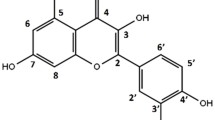Summary
Turmeric (Curcuma longa Linn.) has been shown to inhibit chemical carcinogenesis. In this study, we compared the chemopreventive efficacy of an aqueous turmeric extract (AqTE) and its constituents, curcumin-free aqueous turmeric extract (CFAqTE) and curcumin, using theSalmonella typhimurium mutagenicity assay and the bone marrow micronucleus test in female Swiss mice. AqTE exhibited antimutagenic activity against direct-acting mutagens, 4-nitro-O-phenylenediamine and 1-methyl-3-nitro-1-nitrosoguanidine, in strains TA 98 and TA 100 respectively. Both AqTE and CFAqTE inhibited the mutagenicity of benzo[a]pyrene in the two strains in the presence of Aroclor-1254-induced rat liver homogenate. The inhibition in both studies was dose-dependent. Administration of AqTE, CFAqTE and curcumin at a dose of 3 mg/animal 18 h prior to i.p. benzo[a]-pyrene injection (250 mg/kg) significantly inhibited bone marrow micronuclei formation in female Swiss mice by 43%, 76%, and 65% respectively. Furthermore, the incidence and multiplicity of forestomach tumours induced by benzo[a]pyrene (1 mg/animal, twice weekly, p.o. for 4 weeks) in female Swiss mice were significantly inhibited by AqTE, CFAqTE and curcumin given 2 weeks before, during and after the carcinogen treatment. These data indicate that the protection against genomic damage by turmeric extract and its components tested could be necessary for some aspects of its cancer chemoprevention.
Similar content being viewed by others

Abbreviations
- AqTE:
-
aqueous turmeric extract
- CFAqTE:
-
curcumin-free aqueous turmeric extract
- MNNG:
-
1-methyl-3-nitro-1-nitrosoguanidine
- NDPA:
-
4-nitro-O-phenylenediamine
References
Ames BN, McCann J, Yamasaki E (1975) Methods for detecting carcinogens and mutagens with theSalmonella/mammalian microsome mutagenicity. Mutat Res 31:347–364
Azuine MA (1991) Studies on the chemopreventive agents in tobacco/tobacco-specific nitrosamine induced carcinogenesis. Ph.D. Thesis submitted to University of Bombay, India
Azuine MA, Bhide SV (1992) Chemopreventive effect of turmeric against stomach and skin tumors induced by chemical carcinogens in Swiss mice. Nutr Cancer (in press)
Azuine MA, Sarkar S, Amonkar AJ, Bhide SV (1991) Direct and adjuvant chemoprevention of methyl(acetoxymethyl)nitrosamine induced hamster oral carcinogenesis by betel leaf and turmeric. Int J Cancer (in press)
Bertram JS, Kolonel LN, Meyskens FL Jr (1987) Rationale and strategies for chemoprevention of cancer in humans. Cancer Res 47:3012–3031
Bohr VA, Phillips DH, Hanawalt PC (1987) Heterogenous DNA repair in the mammalian genome. Cancer Res 47:6426–6436
Gichner T, Veleminsky J (1988) Mechanisms of inhibition ofN-nitroso compounds-induced mutagenicity. Mutat Res 202:325–334
hartman PE, Shankel DM (1990) Antimutagens and anticarcinogens: a survey of putative interceptor molecules. Environ Mol Mutagenesis 15:145–182
Hayatsu H, Arimoto S, Negishi T (1988) Dietary inhibitors of mutagenesis and carcinogenesis. Mutat Res 202:429–446
Huang M, Smart RC, Wong C, Conney AH (1988) Inhibitory effect of curcumin, chlorogenic acid, caffeic acid and ferulic acid on tumor promotion in mouse skin by 12-O-tetradecanolphorbol-13-acetate. Cancer Res 48:5941–5946
Jensen NJ (1982) Lack of mutagenic effect of turmeric oleoresin and curcumin in theSalmonella/mammalian microsome test. Mutat Res 105:393–396
Kuttan R, Bhanumathy P, Nirmala K, George MC (1985) Potential anticancer activity of turmeric (Curcuma longa). Cancer Lett 29:197–202
Lahiri M, Maru GB, Bhide SV (1991) Effect of some antimutagenic plant phenols on in vitro3(H)-benzo(a)pyrene-DNA interaction. In: Bhattacharjee SB (ed) Proceedings of Symposium on Environment and Genome, XVIth Annual Conference of Environmental Mutagen Society of India. R. K. Printer, Calcutta, India, pp 368–370
Lowry OH, Rosebrough NJ, Farr AL, Randall RJ (1951) Protein measurement with folin phenol reagent. J Biol Chem 193:265–275
Maron DM, Ames BN (1983) Revised methods for theSalmonella mutagenicity test. Mutat Res 113:173–215
Nagabhushan M, Bhide SV (1986) Nonmutagenicity of curcumin and its antimutagenic action versus chili and capsaicin. Nutr Cancer 8:201–210
Nagabhushan M, Bhide SV (1987) Antimutagenicity and anticarcinogenicity of turmeric (Curcuma longa). J Nutr Growth Cancer 4:83–89
Nagabhushan M, Amonkar AJ, Bhide SV (1987) In vitro antimutagenicity of curcumin against environmental mutagens. Food Chem Toxicol 25:545–547
Ravindranath V, Chandrasekhara N (1982) Metabolism of curcumin — studies with (3H)-curcumin. Toxicology 22:337–344
Salimath BP, Sundaresh CS, Srinivas L (1986) Dietary components inhibit lipid peroxidation in erythrocyte membranes. Nutr Res 6:1171–1178
Schmid W (1975) The micronucleus test. Mutat Res 31:9–15
Shalini VK, Srinivas L (1987) Lipid peroxide induced DNA damage: protection by turmeric (Curcuma longa). Mol Cell Biochem 77:3–10
Shalini VK, Srinivas L (1990) Fuel smoke condensate induced DNA damage in human lymphocytes and protection by turmeric (Curcuma longa). Mol Cell Biochem 95:21–30
Soudamini KK, Kuttan R (1989) Inhibition of chemical carcinogenesis by curcumin. J Ethnopharmacol 27:227–233
Wahlstrom B, Blennow G (1978) A study on the fate of curcumin in the rat. Acta Pharmacol Toxicol 43:86–92
Wattenberg LW (1985) Chemoprevention of cancer. Cancer Res 45:1–8
Wattenberg LW, Coccia JB, Lam LKT (1980) Inhibitory effect of phenolic compounds on benzo(a)pyrene-induced neoplasia. Cancer Res 40:2820–2823
Author information
Authors and Affiliations
Rights and permissions
About this article
Cite this article
Azuine, M.A., Kayal, J.J. & Bhide, S.V. Protective role of aqueous turmeric extract against mutagenicity of direct-acting carcinogens as well as Benzo[a]pyrene-induced genotoxicity and carcinogenicity. J Cancer Res Clin Oncol 118, 447–452 (1992). https://doi.org/10.1007/BF01629428
Received:
Accepted:
Issue Date:
DOI: https://doi.org/10.1007/BF01629428



